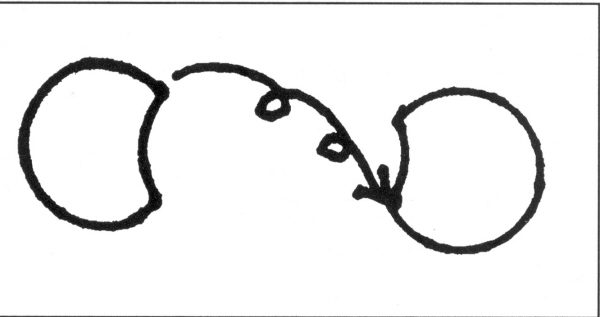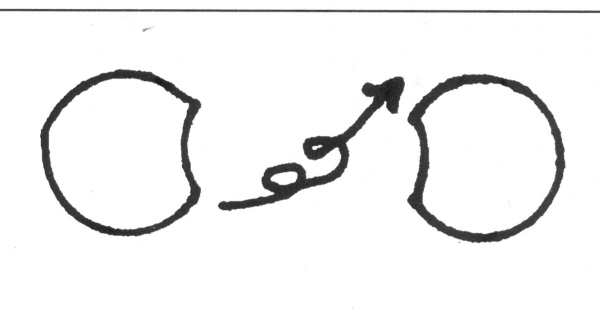
Above - Figure 4 Below - Figure 5 |
 |
Page 32 Spring 1992
|
Doubles,
Triples, Quads Passes that go much higher than normal give your pattern an impressive visual effect. Such passes take longer to get to your partner, thus they have more time to spin. Hence the double, triple, quad, etc., are born.
There
are two basic kinds of doubles that can be thrown easily in a passing
pattern: the early double and the late double. The early double is the
more common of these. It is thrown one count earlier than a normal
pass but takes one count longer to come down, so it arrives in the
normal hand at the normal time, making it very easy to catch.
In
right handed passing, the early double goes
What makes a double spin twice is the time that it is in the air, not a faster than usual spin. Try to make the throw with a normal spin speed but high enough to spin twice. Use mostly your arm, not your wrist, to throw a double. To perfect your doubles, keep watching them land and see what can be improved.
A very common triple can be thrown in a 4-count. This is an early triple; thrown two counts early, it arrives on time. After you've made a right hand pass, instead of throwing a self with the next right, throw a triple pass to your partner's left hand. Then hold up for two counts and resume juggling by doing three selves and a pass. Or you can throw your next right hand as another early triple. If you want, you can make a long sequence of such right-to-Ieft triples, each arriving at just the right time and each such throw followed by a pause (the rhythm is: self, triple, hold, hold).
While the above 4-count triple is well known, here is a less common but quite workable triple for a 2count pattern. Like an early double, this triple pass is thrown from the left hand one count before a normal single pass would occur, but the triple is thrown to your partner's right hand. As with early and late doubles, this left-to-right triple can be used in a 2count, a 4-count or a 3-count. It is thrown one count early and arrives one count late, so both jugglers have to hold up for one count. When throwing this triple in a 2-count, you'll be throwing it just as you're catching a pass in the same hand. If that incoming pass is at all low, throw the triple from a little inside to avoid a collision.
In a 2-count, you can throw consecutive early throws with alternating hands by making each throw one spin higher. The simplest version of this is the double-triple. A double is thrown left to left, then immediately a triple is thrown right to left. You can even follow that with a quad (four spins) thrown left to left. You'll find, however, that you run out of clubs at this point (unless you stocked up with an extra club earlier!).
If, instead, you throw a late combination to your partner's right hand, starting with a right-to-right double, then you can actually get up to a quint (five spins) before running out of clubs. So you can follow the right-to-right double with a left-to-right triple, a right-to-right quad and finally a left-to-right quint. Work up to the higher combinations slowly, mastering the feel of the double-triple before attempting the double-triple-quad, and so forth.
One warning: When you are catching a very high throw like a quad or quint, or even a triple, the club comes down at a very high speed and can hurt if you catch it wrong or it hits you when you're not watching. So be sure to keep the high throws outside for safety and be very careful when catching a high throw. If you're not sure about the spin, let the club drop to the ground.
When throwing combinations like this, try to make each throw independently. That is, throw the double as if it were all you were going te do, then throw a triple as if it were the last special throw, and only then let yourself realize that you want to throw a quad. This is important, since many people tend to overthrow or underthrow one throw because they're already gearing up for the following throw. That can happen even to the normal single that precedes any individual special throw. Try to throw that single normally before starting a trick. |

Above - Figure 4 Below - Figure 5 |
 |